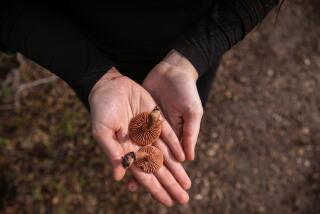Solving the mystery of the missing morels
THURMONT, MD. — When spring nights turn mild and the poplar trees are tinged with green, Betty Calimer and her family start scanning the forest floor for morels.
The mushrooms have been prized by generations of home cooks and gourmet chefs, but fungus hunters are finding fewer in the western Maryland woods.
“We used to find them by the dishpan full, but not now,” said Calimer, 75, of Sabillasville, who started picking mushrooms in the Catoctin Mountains as a girl. In recent years, she could barely find enough on a good day to fill a bread bag, Calimer said.
Now researchers from the U.S. Forest Service and Rutgers University are asking mushroom hunters to help them figure out why morels are disappearing and how to sustain future harvests.
Elizabeth Barron, a Rutgers graduate student in geography, aims to interview 50 people this season about their experiences gathering morels in two national parks -- Catoctin Mountain Park near Thurmont, and the Chesapeake and Ohio Canal National Historical Park, which parallels the Potomac River for nearly 185 miles from Washington to Cumberland.
This is the third year of the four-year study, funded by $97,000 from the National Park Service. It is the first scientific examination of morel harvesting east of the Mississippi River, according to Barron and Marla Emery, a U.S. Forest Service geographer from Burlington, Vt., who is the lead investigator.
Harvesters know at least as much about the mushrooms as mycologists and forest managers, Barron said recently while scouting likely morel spots in the Catoctins.
“There’s generations of knowledge there,” she said.
David Draper, 47, of Hagerstown, is an example. He learned from his parents and has taught his children to look for the wrinkled, elongated cones near poplar, ash and elm trees and in old apple orchards. He likes his mushrooms covered in batter and fried with eggs, a popular recipe.
“I think they’re a delicacy,” Draper said.
Diners at many high-priced restaurants think so too. Increased harvesting of morels, which sell online for $23 to $40 a pound, is one of several possible factors behind the lower mushroom numbers reported by local pickers and park managers, Barron and Emery said. Other variables include the loss of forests to development, rising populations of mushroom-eating deer and warmer weather.
Barron and Emery hope to determine whether morel populations really are declining in the area. There has been no reported decline in the Pacific Northwest, where wild morels are a multimillion-dollar business. The researchers also will document harvester experiences and practices, and make recommendations for sustainable harvests.
The rules for mushroom hunting on federal lands vary from park to park. Harvesters may take an unlimited number of morels for personal use from Catoctin Mountain Park, but only half a gallon a day along the C&O; Canal.
Some national forests in the Pacific Northwest require people to obtain free permits before picking for personal consumption, and designate entire campgrounds for commercial pickers, according to a 2005 Forest Service report. Barron said there was no possibility that her report would recommend permits for morel harvesting on federal lands in Maryland.
In interviews with morel pickers, Barron starts by reassuring them she isn’t interested in learning their hunting spots.
“That’s kind of like sacred -- like a really guarded family secret,” she said.
Calimer’s son-in-law, Richard Masser, proved that point when someone asked during one of Barron’s recent group presentations what morels taste like.
“They taste so good that I’ll never take you where I find them,” he said.






